![[Previous]](../../../buttons/fprev.png)
![[Next]](../../../buttons/fnext.png)
DTC P0340: Intake
Camshaft Position Sensor Circuit
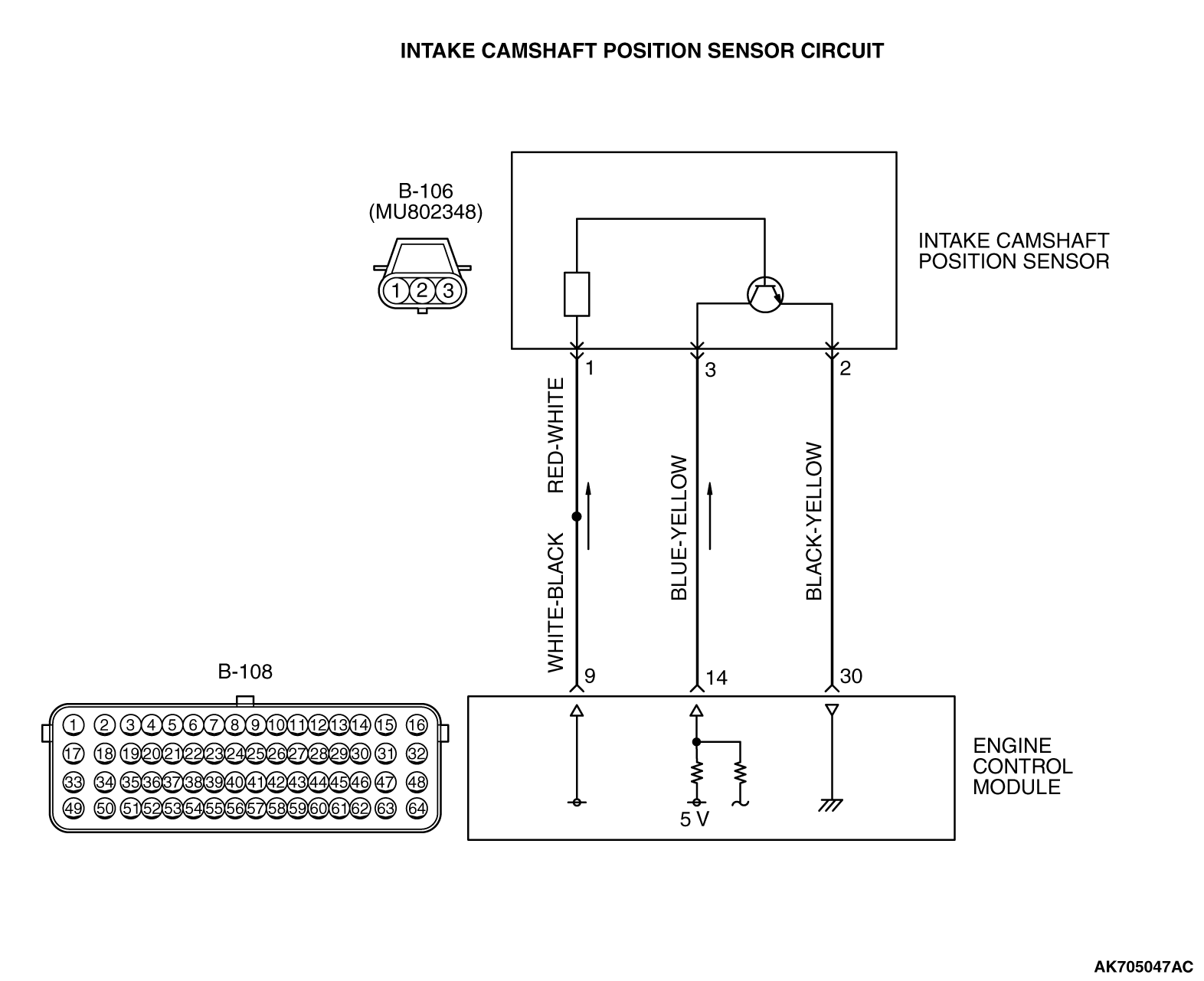
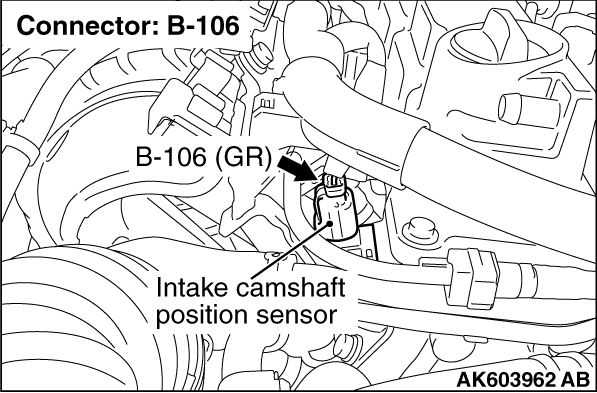
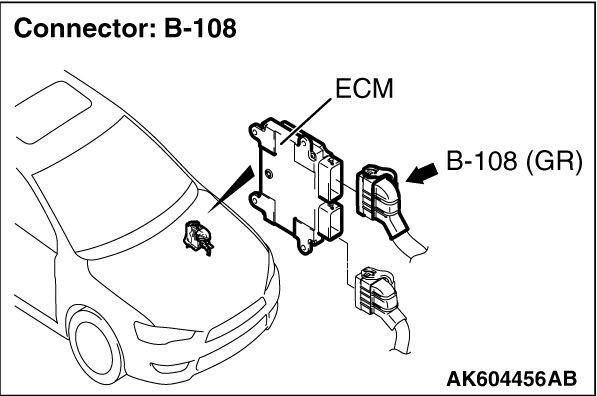
CIRCUIT OPERATION
- The intake camshaft position sensor power is supplied
from the ECM (terminal No. 9).
- Terminal No. 2 of the intake camshaft position sensor is grounded with ECM (terminal
No. 30).
- A 5-volt voltage is applied on the intake camshaft position sensor output terminal
(terminal No. 3) from the ECM (terminal No. 14). The intake camshaft position sensor generates
a pulse signal when the output terminal is opened and grounded.
TECHNICAL DESCRIPTION
- The intake camshaft position sensor detects the position
of the intake camshaft and inputs the pulse signal to the ECM.
- In response to the intake camshaft position sensor signal and the crankshaft sensor
signal, the ECM detects the compression top dead center of the No. 1 cylinder.
- Also, in response to the intake camshaft position sensor signal, the ECM controls
variable valve timing (V.V.T.).
DESCRIPTIONS OF MONITOR METHODS
- Intake camshaft position sensor signal does not change.
- Intake camshaft position sensor signal is not normal pattern.
MONITOR EXECUTION
MONITOR EXECUTION CONDITIONS (Other monitor and Sensor)
Other Monitor (There is no temporary DTC stored in memory
for the item monitored below)
Sensor (The sensor below is determined to be normal)
DTC SET CONDITIONS <Circuit continuity>
Logic Flow Chart
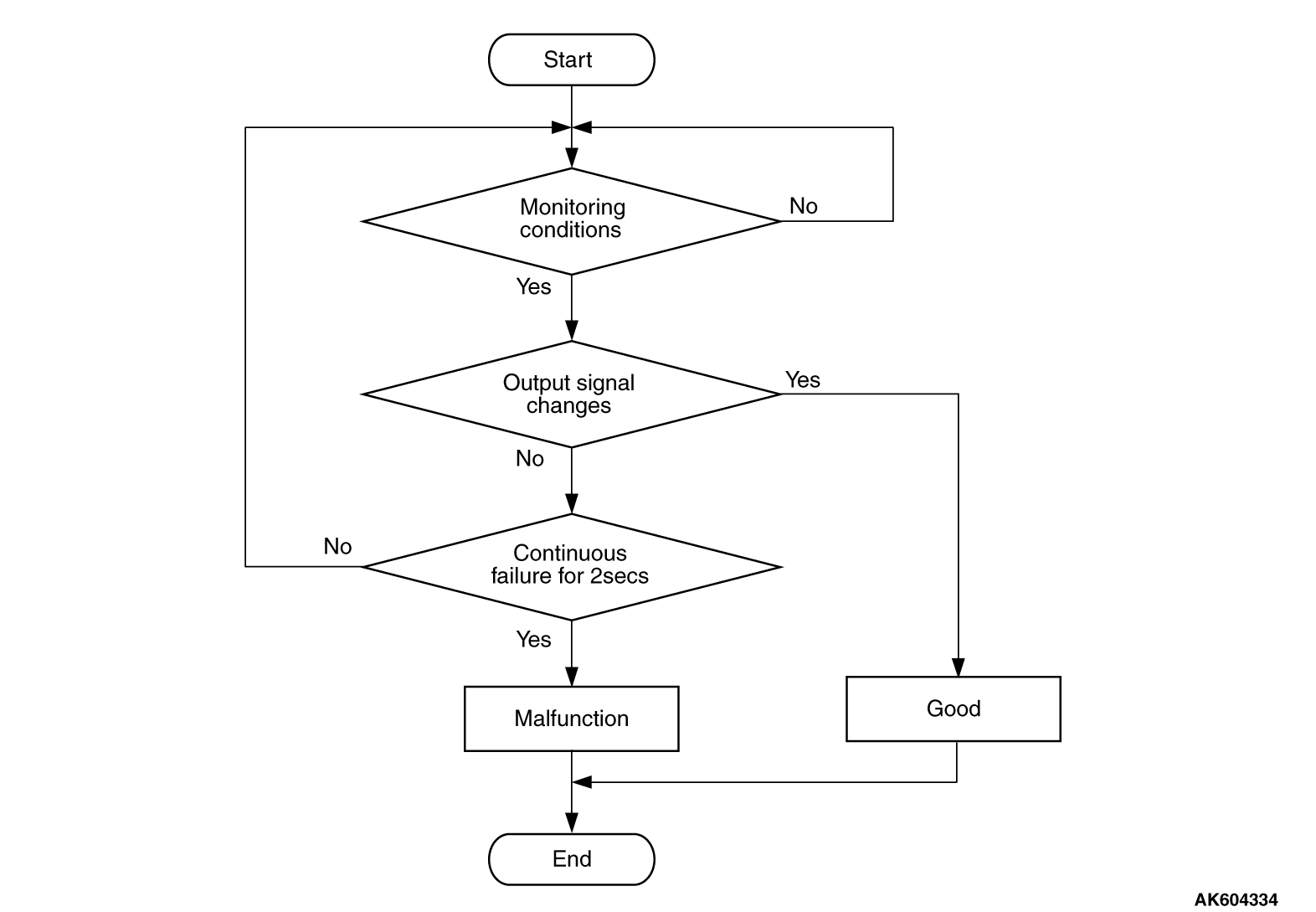
Check Condition
or
- Engine speed is higher than 500 r/min excluding during cranking.
Judgement Criterion
- Intake camshaft position sensor output voltage has not changed (no pulse signal
is input) for 2 seconds.
DTC SET CONDITIONS <Range/Performance problem - alignment>
Logic Flow Chart
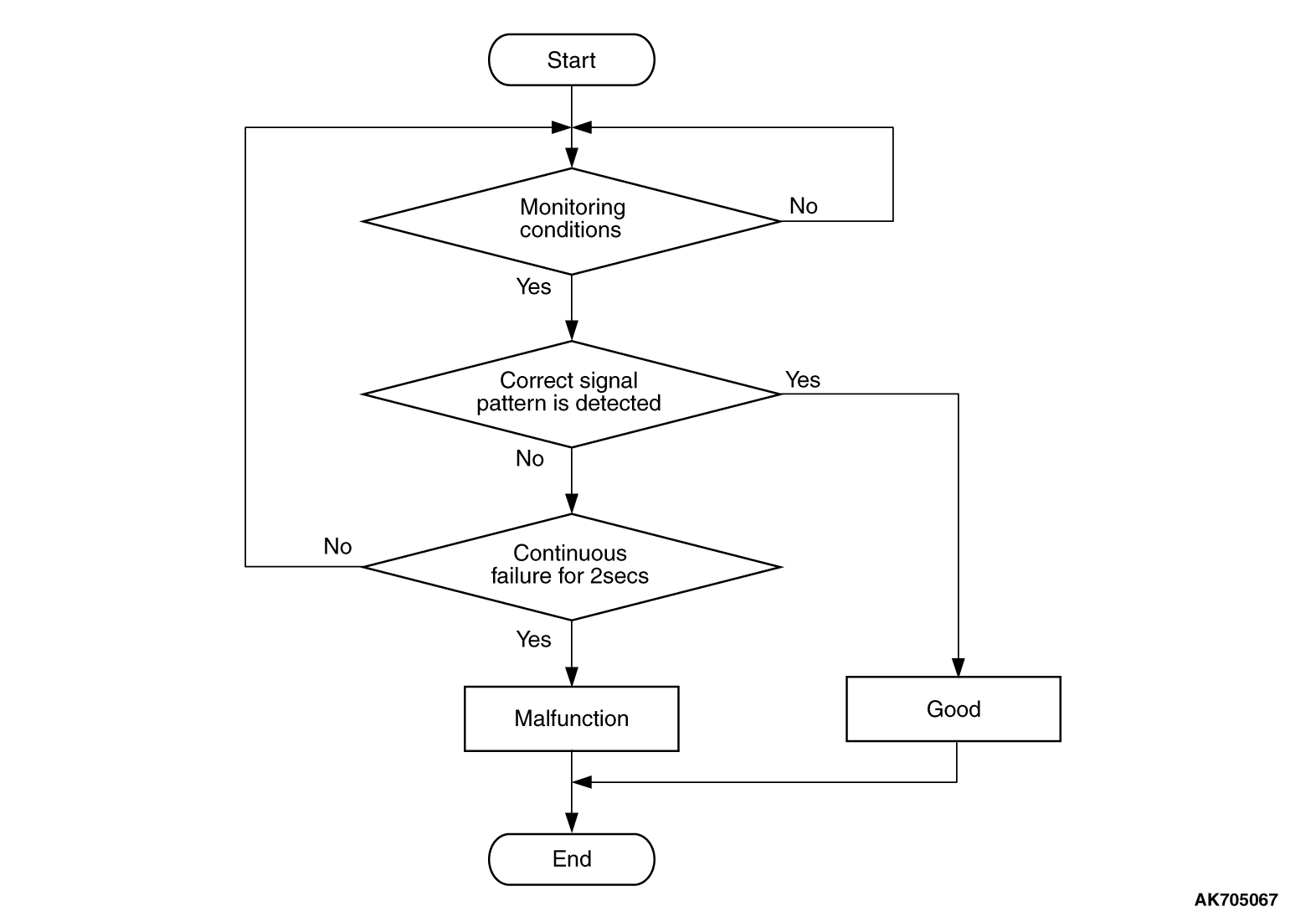
Check Condition
or
- Engine speed is higher than 500 r/min excluding during cranking.
Judgement Criterion
- Normal signal pattern has not been input for cylinder identification from the crankshaft
position sensor signal and intake camshaft position sensor signal for 2 seconds.
OBD-II DRIVE CYCLE PATTERN
Refer to Diagnostic Function - OBD-II Drive Cycle - Pattern
23  .
.
TROUBLESHOOTING HINTS (The most likely causes for this code to be set are: )
- Intake camshaft position sensor failed.
- Open or shorted intake camshaft position sensor circuit, or harness damage, or connector damage.
- Intake camshaft failed.
- ECM failed.
|
|
Required Special Tools:
- MB991709: Test Harness
- MB992110: Power Plant ECU Check Harness
|
|
|
STEP 1. Using the oscilloscope, check the intake camshaft position
sensor.
|
|
|
(1)Disconnect the intake camshaft position sensor connector B-106, and connect test
harness special tool (MB991709) between the separated connectors. (All terminals should be connected.)
|
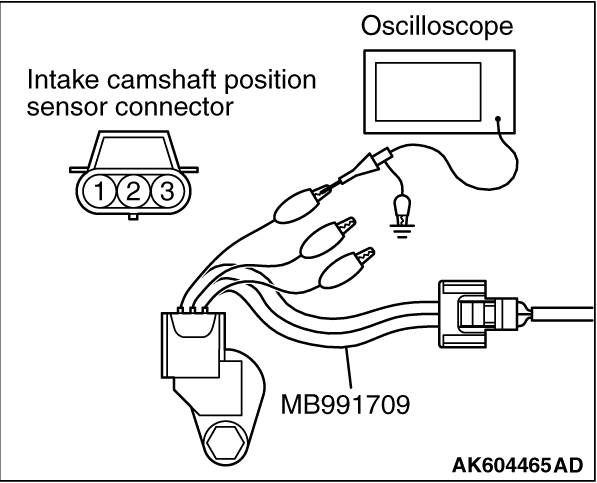
|
(2)Connect the oscilloscope probe to the intake camshaft position sensor side connector terminal
No. 3.
| note |
When measuring with the ECM side connector, disconnect all ECM connectors. Connect the
check harness special tool (MB992110) between the separated connectors. Then connect the oscilloscope
probe to the check harness connector terminal No. 14.
|
(3)Start the engine and run at idle.
|
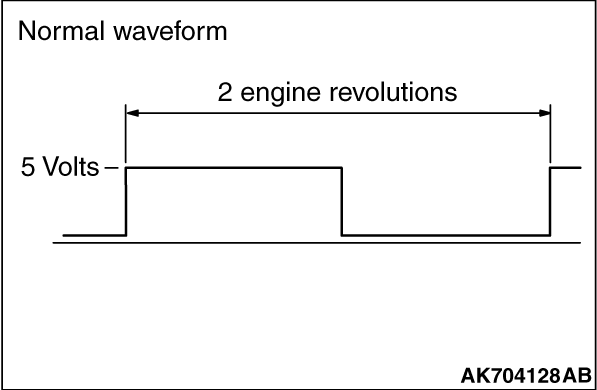
|
(4)Check the waveform.
- The waveform should show a pattern similar to the illustration.
(5)Turn the ignition switch to the "LOCK" (OFF) position.
Q.
Is the waveform normal?
 Go to Step 2. Go to Step 2.
 Go to Step 4. Go to Step 4.
|
|
|
STEP 2. Check harness connector B-106 at intake camshaft position
sensor and harness connector B-108 at ECM for damage.
|
|
|
Q.
Is the harness connector in good condition?
|
|
|
 Go to Step 3. Go to Step 3.
|
|
|
|
|
|
 Repair or replace it. Refer to GROUP 00E, Harness Connector Inspection Repair or replace it. Refer to GROUP 00E, Harness Connector Inspection  .
Then go to Step 19. .
Then go to Step 19.
|
|
|
|
|
|
STEP 3. Check the trouble symptoms.
|
|
|
(1)Carry out a test drive with the drive cycle pattern. Refer to Diagnostic Function - OBD-II
Drive Cycle - Pattern 23  . .
|
|
|
(2)Check the diagnostic trouble code (DTC).
|
|
|
 Replace the ECM. When the ECM is replaced, register the ID code. Refer to GROUP
42B, Diagnosis - ID Code Registration Judgment Table <Vehicles with KOS> Replace the ECM. When the ECM is replaced, register the ID code. Refer to GROUP
42B, Diagnosis - ID Code Registration Judgment Table <Vehicles with KOS>  or
GROUP 42C, Diagnosis - ID Codes Registration Judgment Table <Vehicles with WCM> or
GROUP 42C, Diagnosis - ID Codes Registration Judgment Table <Vehicles with WCM>  .
Then go to Step 19. .
Then go to Step 19.
|
|
|
|
|
|
 It can be assumed that this malfunction is intermittent. Refer to GROUP 00, How
to Use Troubleshooting/Inspection Service Points - How to Cope with Intermittent
Malfunctions It can be assumed that this malfunction is intermittent. Refer to GROUP 00, How
to Use Troubleshooting/Inspection Service Points - How to Cope with Intermittent
Malfunctions  . .
|
|
|
|
|
|
STEP 4. Check harness connector B-106 at intake camshaft position
sensor for damage.
|
|
|
Q.
Is the harness connector in good condition?
|
|
|
 Go to Step 5. Go to Step 5.
|
|
|
|
|
|
 Repair or replace it. Refer to GROUP 00E, Harness Connector Inspection Repair or replace it. Refer to GROUP 00E, Harness Connector Inspection  .
Then go to Step 19. .
Then go to Step 19.
|
|
|
|
|
|
STEP 5. Measure the sensor supply voltage at intake camshaft position
sensor connector B-106.
|
|
|
(1)Disconnect the connector B-106 and measure at the harness side.
|
|
|
(2)Turn the ignition switch to the "ON" position.
|
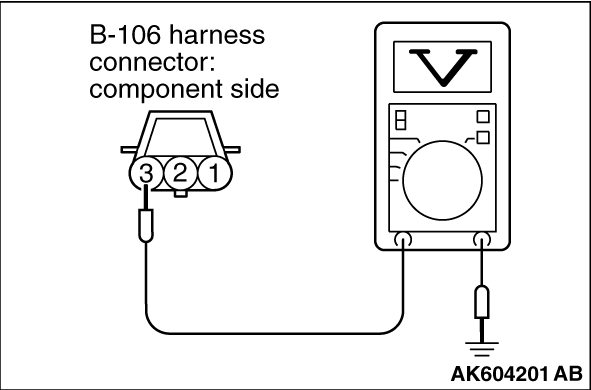
|
(3)Measure the voltage between terminal No. 3 and ground.
- Voltage should be between 4.9 and 5.1 volts.
(4)Turn the ignition switch to the "LOCK" (OFF) position.
Q.
Is the measured voltage between 4.9 and 5.1 volts?
 Go to Step 9. Go to Step 9.
 Go to Step 6. Go to Step 6.
|
|
|
STEP 6. Check harness connector B-108 at ECM for damage.
|
|
|
Q.
Is the harness connector in good condition?
|
|
|
 Go to Step 7. Go to Step 7.
|
|
|
|
|
|
 Repair or replace it. Refer to GROUP 00E, Harness Connector Inspection Repair or replace it. Refer to GROUP 00E, Harness Connector Inspection  .
Then go to Step 19. .
Then go to Step 19.
|
|
|
|
|
|
STEP 7. Measure the sensor supply voltage at ECM connector B-108 by
using power plant ECU check harness special tool MB992110.
|
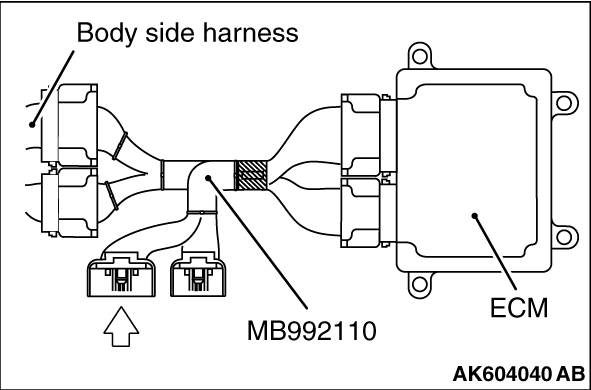
|
(1)Disconnect the all ECM connectors. Connect the power plant ECU check harness special
tool MB992110 between the separated connectors.
(2)Disconnect the intake camshaft position sensor connector B-106.
(3)Turn the ignition switch to the "ON" position.
|
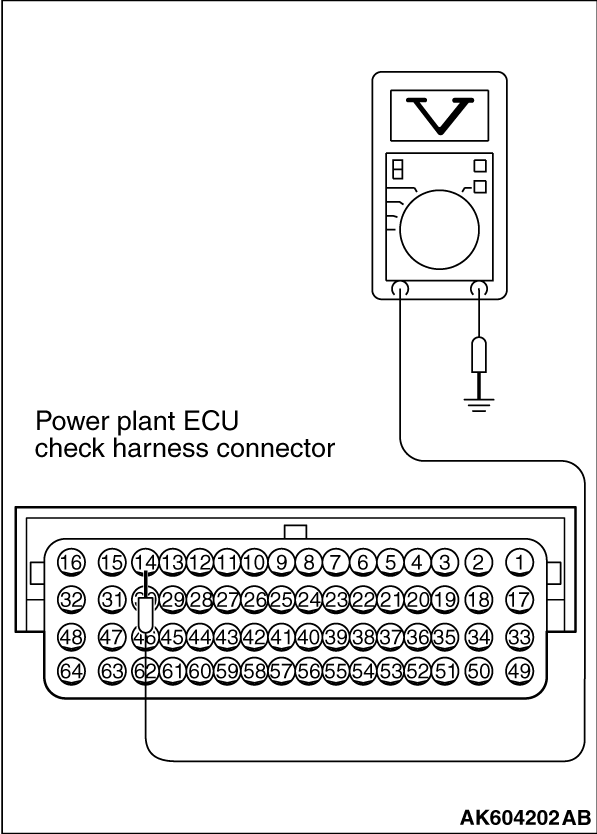
|
(4)Measure the voltage between terminal No. 14 and ground.
- Voltage should be between 4.9 and 5.1 volts.
(5)Turn the ignition switch to the "LOCK" (OFF) position.
Q.
Is the measured voltage between 4.9 and 5.1 volts?
 Repair harness wire between intake camshaft position sensor connector B-106 (terminal
No. 3) and ECM connector B-108 (terminal No. 14) because of open circuit. Then go to Step 19. Repair harness wire between intake camshaft position sensor connector B-106 (terminal
No. 3) and ECM connector B-108 (terminal No. 14) because of open circuit. Then go to Step 19.
 Go to Step 8. Go to Step 8.
|
|
|
STEP 8. Check for short circuit to ground between intake camshaft
position sensor connector B-106 (terminal No. 3) and ECM connector B-108 (terminal No. 14).
|
|
|
Q.
Is the harness wire in good condition?
|
|
|
 Replace the ECM. When the ECM is replaced, register the ID code. Refer to GROUP
42B, Diagnosis - ID Code Registration Judgment Table <Vehicles with KOS> Replace the ECM. When the ECM is replaced, register the ID code. Refer to GROUP
42B, Diagnosis - ID Code Registration Judgment Table <Vehicles with KOS>  or
GROUP 42C, Diagnosis - ID Codes Registration Judgment Table <Vehicles with WCM> or
GROUP 42C, Diagnosis - ID Codes Registration Judgment Table <Vehicles with WCM>  .
Then go to Step 19. .
Then go to Step 19.
|
|
|
|
|
|
 Repair it. Then go to Step 19. Repair it. Then go to Step 19.
|
|
|
|
|
|
STEP 9. Measure the power supply voltage at intake camshaft position
sensor connector B-106.
|
|
|
(1)Disconnect the connector B-106 and measure at the harness side.
|
|
|
(2)Turn the ignition switch to the "ON" position.
|
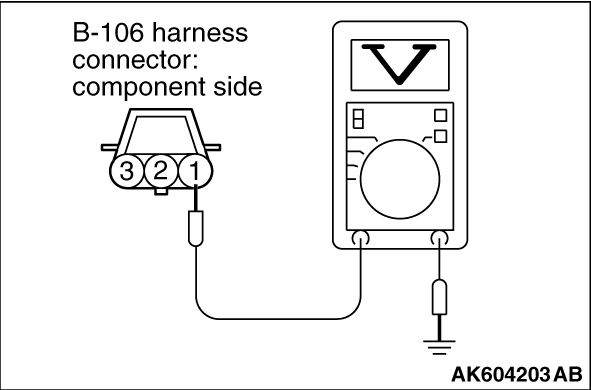
|
(3)Measure the voltage between terminal No. 1 and ground.
- Voltage should be between 4.9 and 16.0 volts.
(4)Turn the ignition switch to the "LOCK" (OFF) position.
Q.
Is the measured voltage between 4.9 and 16.0 volts?
 Go to Step 12. Go to Step 12.
 Go to Step 10. Go to Step 10.
|
|
|
STEP 10. Check harness connector B-108 at ECM for damage.
|
|
|
Q.
Is the harness connector in good condition?
|
|
|
 Go to Step 11. Go to Step 11.
|
|
|
|
|
|
 Repair or replace it. Refer to GROUP 00E, Harness Connector Inspection Repair or replace it. Refer to GROUP 00E, Harness Connector Inspection  .
Then go to Step 19. .
Then go to Step 19.
|
|
|
|
|
|
STEP 11. Check for open circuit and short circuit to ground between
intake camshaft position sensor connector B-106 (terminal No. 1) and ECM connector B-108 (terminal
No. 9).
|
|
|
Q.
Is the harness wire in good condition?
|
|
|
 Replace the ECM. When the ECM is replaced, register the ID code. Refer to GROUP
42B, Diagnosis - ID Code Registration Judgment Table <Vehicles with KOS> Replace the ECM. When the ECM is replaced, register the ID code. Refer to GROUP
42B, Diagnosis - ID Code Registration Judgment Table <Vehicles with KOS>  or
GROUP 42C, Diagnosis - ID Codes Registration Judgment Table <Vehicles with WCM> or
GROUP 42C, Diagnosis - ID Codes Registration Judgment Table <Vehicles with WCM>  .
Then go to Step 19. .
Then go to Step 19.
|
|
|
|
|
|
 Repair it. Then go to Step 19. Repair it. Then go to Step 19.
|
|
|
|
|
|
STEP 12. Check the continuity at intake camshaft position sensor connector
B-106.
|
|
|
(1)Disconnect the connector B-106 and measure at the harness side.
|
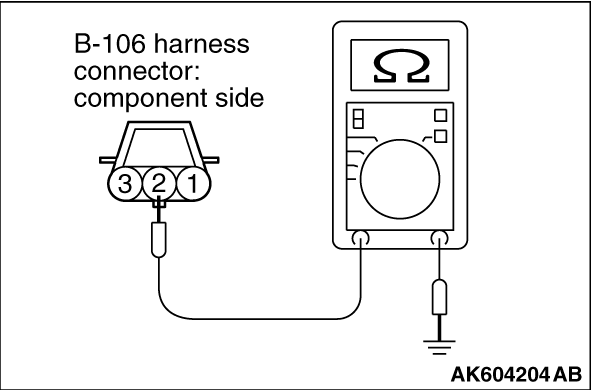
|
(2)Check for the continuity between terminal No. 2 and ground.
- Continuity (2 Ω or less).
Q.
Does continuity exist?
 Go to Step 15. Go to Step 15.
 Go to Step 13. Go to Step 13.
|
|
|
STEP 13. Check harness connector B-108 at ECM for damage.
|
|
|
Q.
Is the harness connector in good condition?
|
|
|
 Go to Step 14. Go to Step 14.
|
|
|
|
|
|
 Repair or replace it. Refer to GROUP 00E, Harness Connector Inspection Repair or replace it. Refer to GROUP 00E, Harness Connector Inspection  .
Then go to Step 19. .
Then go to Step 19.
|
|
|
|
|
|
STEP 14. Check for open circuit and harness damage between intake
camshaft position sensor connector B-106 (terminal No. 2) and ECM connector B-108 (terminal
No. 30).
|
|
|
Q.
Is the harness wire in good condition?
|
|
|
 Replace the ECM. When the ECM is replaced, register the ID code. Refer to GROUP
42B, Diagnosis - ID Code Registration Judgment Table <Vehicles with KOS> Replace the ECM. When the ECM is replaced, register the ID code. Refer to GROUP
42B, Diagnosis - ID Code Registration Judgment Table <Vehicles with KOS>  or
GROUP 42C, Diagnosis - ID Codes Registration Judgment Table <Vehicles with WCM> or
GROUP 42C, Diagnosis - ID Codes Registration Judgment Table <Vehicles with WCM>  .
Then go to Step 19. .
Then go to Step 19.
|
|
|
|
|
|
 Repair it. Then go to Step 19. Repair it. Then go to Step 19.
|
|
|
|
|
|
STEP 15. Check harness connector B-108 at ECM for damage.
|
|
|
Q.
Is the harness connector in good condition?
|
|
|
 Go to Step 16. Go to Step 16.
|
|
|
|
|
|
 Repair or replace it. Refer to GROUP 00E, Harness Connector Inspection Repair or replace it. Refer to GROUP 00E, Harness Connector Inspection  .
Then go to Step 19. .
Then go to Step 19.
|
|
|
|
|
|
STEP 16. Check for harness damage between ECM connector B-108 (terminal
No. 9) and intake camshaft position sensor connector B-106 (terminal No. 1).
|
|
|
Q.
Is the harness wire in good condition?
|
|
|
 Go to Step 17. Go to Step 17.
|
|
|
|
|
|
 Repair it. Then go to Step 19. Repair it. Then go to Step 19.
|
|
|
|
|
|
STEP 17. Check for harness damage between intake camshaft position
sensor connector B-106 (terminal No. 3) and ECM connector B-108 (terminal No. 14).
|
|
|
Q.
Is the harness wire in good condition?
|
|
|
 Go to Step 18. Go to Step 18.
|
|
|
|
|
|
 Repair it. Then go to Step 19. Repair it. Then go to Step 19.
|
|
|
|
|
|
STEP 18. Check the intake camshaft position sensing portion.
|
|
|
Q.
Is the intake camshaft position sensing portion in good condition?
|
|
|
 Replace the intake camshaft position sensor. Then go to Step 19. Replace the intake camshaft position sensor. Then go to Step 19.
|
|
|
|
|
|
 Replace the intake camshaft. Then go to Step 19. Replace the intake camshaft. Then go to Step 19.
|
|
|
|
|
|
STEP 19. Test the OBD-II drive cycle.
|
|
|
(1)Carry out a test drive with the drive cycle pattern. Refer to Diagnostic Function - OBD-II
Drive Cycle - Pattern 23  . .
|
|
|
(2)Check the diagnostic trouble code (DTC).
|
|
|
 Retry the troubleshooting. Retry the troubleshooting.
|
|
|
|
|
|
 The inspection is complete. The inspection is complete.
|
|
|
|
 .
.![[Previous]](../../../buttons/fprev.png)
![[Next]](../../../buttons/fnext.png)





 .
.
 Go to Step 2.
Go to Step 2. Go to Step 4.
Go to Step 4. Go to Step 3.
Go to Step 3. Repair or replace it. Refer to GROUP 00E, Harness Connector Inspection
Repair or replace it. Refer to GROUP 00E, Harness Connector Inspection  .
Then go to Step 19.
.
Then go to Step 19. .
. Replace the ECM. When the ECM is replaced, register the ID code. Refer to GROUP
42B, Diagnosis - ID Code Registration Judgment Table <Vehicles with KOS>
Replace the ECM. When the ECM is replaced, register the ID code. Refer to GROUP
42B, Diagnosis - ID Code Registration Judgment Table <Vehicles with KOS>  or
GROUP 42C, Diagnosis - ID Codes Registration Judgment Table <Vehicles with WCM>
or
GROUP 42C, Diagnosis - ID Codes Registration Judgment Table <Vehicles with WCM>  .
Then go to Step 19.
.
Then go to Step 19. It can be assumed that this malfunction is intermittent. Refer to GROUP 00, How
to Use Troubleshooting/Inspection Service Points - How to Cope with Intermittent
Malfunctions
It can be assumed that this malfunction is intermittent. Refer to GROUP 00, How
to Use Troubleshooting/Inspection Service Points - How to Cope with Intermittent
Malfunctions  .
. Go to Step 5.
Go to Step 5. Repair or replace it. Refer to GROUP 00E, Harness Connector Inspection
Repair or replace it. Refer to GROUP 00E, Harness Connector Inspection  .
Then go to Step 19.
.
Then go to Step 19.
 Go to Step 9.
Go to Step 9. Go to Step 6.
Go to Step 6. Go to Step 7.
Go to Step 7. Repair or replace it. Refer to GROUP 00E, Harness Connector Inspection
Repair or replace it. Refer to GROUP 00E, Harness Connector Inspection  .
Then go to Step 19.
.
Then go to Step 19.

 Repair harness wire between intake camshaft position sensor connector B-106 (terminal
No. 3) and ECM connector B-108 (terminal No. 14) because of open circuit. Then go to Step 19.
Repair harness wire between intake camshaft position sensor connector B-106 (terminal
No. 3) and ECM connector B-108 (terminal No. 14) because of open circuit. Then go to Step 19.
 Go to Step 8.
Go to Step 8. Replace the ECM. When the ECM is replaced, register the ID code. Refer to GROUP
42B, Diagnosis - ID Code Registration Judgment Table <Vehicles with KOS>
Replace the ECM. When the ECM is replaced, register the ID code. Refer to GROUP
42B, Diagnosis - ID Code Registration Judgment Table <Vehicles with KOS>  or
GROUP 42C, Diagnosis - ID Codes Registration Judgment Table <Vehicles with WCM>
or
GROUP 42C, Diagnosis - ID Codes Registration Judgment Table <Vehicles with WCM>  .
Then go to Step 19.
.
Then go to Step 19. Repair it. Then go to Step 19.
Repair it. Then go to Step 19.
 Go to Step 12.
Go to Step 12. Go to Step 10.
Go to Step 10. Go to Step 11.
Go to Step 11. Repair or replace it. Refer to GROUP 00E, Harness Connector Inspection
Repair or replace it. Refer to GROUP 00E, Harness Connector Inspection  .
Then go to Step 19.
.
Then go to Step 19. Replace the ECM. When the ECM is replaced, register the ID code. Refer to GROUP
42B, Diagnosis - ID Code Registration Judgment Table <Vehicles with KOS>
Replace the ECM. When the ECM is replaced, register the ID code. Refer to GROUP
42B, Diagnosis - ID Code Registration Judgment Table <Vehicles with KOS>  or
GROUP 42C, Diagnosis - ID Codes Registration Judgment Table <Vehicles with WCM>
or
GROUP 42C, Diagnosis - ID Codes Registration Judgment Table <Vehicles with WCM>  .
Then go to Step 19.
.
Then go to Step 19. Repair it. Then go to Step 19.
Repair it. Then go to Step 19.
 Go to Step 15.
Go to Step 15. Go to Step 13.
Go to Step 13. Go to Step 14.
Go to Step 14. Repair or replace it. Refer to GROUP 00E, Harness Connector Inspection
Repair or replace it. Refer to GROUP 00E, Harness Connector Inspection  .
Then go to Step 19.
.
Then go to Step 19. Replace the ECM. When the ECM is replaced, register the ID code. Refer to GROUP
42B, Diagnosis - ID Code Registration Judgment Table <Vehicles with KOS>
Replace the ECM. When the ECM is replaced, register the ID code. Refer to GROUP
42B, Diagnosis - ID Code Registration Judgment Table <Vehicles with KOS>  or
GROUP 42C, Diagnosis - ID Codes Registration Judgment Table <Vehicles with WCM>
or
GROUP 42C, Diagnosis - ID Codes Registration Judgment Table <Vehicles with WCM>  .
Then go to Step 19.
.
Then go to Step 19. Repair it. Then go to Step 19.
Repair it. Then go to Step 19. Go to Step 16.
Go to Step 16. Repair or replace it. Refer to GROUP 00E, Harness Connector Inspection
Repair or replace it. Refer to GROUP 00E, Harness Connector Inspection  .
Then go to Step 19.
.
Then go to Step 19. Go to Step 17.
Go to Step 17. Repair it. Then go to Step 19.
Repair it. Then go to Step 19. Go to Step 18.
Go to Step 18. Repair it. Then go to Step 19.
Repair it. Then go to Step 19. Replace the intake camshaft position sensor. Then go to Step 19.
Replace the intake camshaft position sensor. Then go to Step 19. Replace the intake camshaft. Then go to Step 19.
Replace the intake camshaft. Then go to Step 19. .
. Retry the troubleshooting.
Retry the troubleshooting. The inspection is complete.
The inspection is complete.